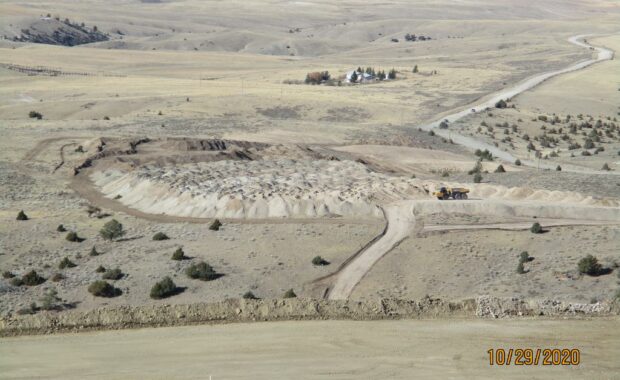
Topsoil is perhaps the most important resource required for successful and rapid revegetation of reclamation, restoration, and construction projects. Revegetation is critical for reducing soil erosion and subsequent off-site sedimentation. When planning for topsoil salvage, first consider local, State, and Federal requirements. The Surface Mining Control and Reclamation Act (SMCRA, 1977) was the first federal statute to define handling and storage of topsoil resources in mining operations. One must also understand the future uses of the topsoil and the reclaimed landscape. It is equally important to compliment the operations of the larger management action that drives the need for salvaged topsoil. Our experiences with Montana mining projects involve large topsoil salvage and storage campaigns. We typically deal with historic and new topsoil stockpiles (TSPs) having 1 to 4-acre footprints, and collectively storing many hundreds of thousands of cubic yards at each individual mine site.
A County Soil Survey prepared by the Natural Resources Conservation Service is a great place to start a soil resource assessment. More detailed investigations may require the delineation of the spatial extent of the physical, chemical, and biological soil qualities. For example, identifying the variability of topsoil (OM/A horizon) and subsoil (B, C horizon) depths, texture and rock content, problem soils (sodicity, pH, clay content), presence of State- and County-listed noxious weeds, and cultural resources.
Initially, ensure that all equipment is clean and free of noxious weed-contaminated soil material. Then clear, separate, and store existing vegetation. Salvage and store OM and A horizon topsoils separately from subsoils and problem soils; and separate distinctly unique soil types if they exist. Use permanent signage to identify unique TSPs and document their location and volume. Locate TSPs to avoid critical future land uses and activities. Route and schedule hauling of salvaged materials to minimize traffic conflicts and soil compaction. Direct-haul techniques are highly advantageous, where salvaged soil is transported directly to active reclamation sites, eliminating the need for stockpiling. Also, position the TSPs where they can most efficiently be used for future reclamation actions. Placement of specific TSPs based on timing of their use may be important. TSP construction is dictated by the type of equipment available, the shape and allowable area of the receiving landscape, and proximity to future areas of topsoil application. Select elevated topography, avoid drainage-ways and depressions, and ensure run-on waters do not reach the TSPs. The TSPs should ideally be less than 2 meters in depth if retention of soil biota is expected. Years of burial below 1 or 2 meters will greatly reduce soil biota, organic carbon, and other soil nutrients; due to anaerobic conditions and disruption of soil forming and sustaining processes. A dome-shaped pile with side slopes of < 3H:1V will allow for safe and easier mechanical seed application and vehicular access for future noxious weed control efforts. Most commonly the final contouring of TSPs will be performed by LGP bulldozers. If so, afford the expense of having the dozers thoroughly “track-walk” the entire TSP surface area so that grouzer-tracks are imprinted on contour, to inhibit water erosion, and form ideal seedbeds. Broadcast seeding, then harrowing, should be performed soon after. If perimeter fencing or structures are installed or already exists, leave enough room at the toe of the TSP to allow for maneuvering of seeding and maintenance equipment. Use cover crops and non-native grass species for the most rapid revegetation results (See our previous articles on Cover Crops Technologies and Seed Mix Design). After all, these are temporary features, and should not be managed as “Final Reclamation”. Select forbs and legumes that are affordable, fix nitrogen, and emerge rapidly. Most of our TSPs projects have high rock content and slopes >3H:1V, so we perform seedbed preparation, broadcast seeding, and noxious weed control with small, low-profile equipment.
Prepare by John F. Whittingham, Owner, Basic Biological Services LLC, Dillon, Montana. info@basicbiologicalservices.com; www.basicbiologicalservices.com
